Abstract
Brownian dynamics (BD) method was employed to calculate the single fiber deposition efficiencies of electrically neutral, submicron aerosol particles in bipolarly charged and non-charged fibrous filters. It was found that a considerable increase in the deposition efficiency can be achieved by increasing the fiber charge density and that it is accompanied by a noticeable shift of the most penetrating particles size towards smaller particles. The results of the BD simulations obtained for various fiber charge densities and various particle diameters allowed us to derive new formulae relating a gain in the deposition efficiency due to action of the electrostatic force to the dimensionless polarization parameter, N σ 0 . These equations are applicable in much wider range of N σ 0 than other correlations available in the literature. A simple approximate rule for recalculating the form of the proposed formulae for another filter packing density was also presented. Theoretically predicted values of the deposition efficiency in bipolar electret filters were compared with our own experimental data as well as with the data available in the literature and a satisfactory agreement, better than in the case of other existing correlations, was obtained.
1. INTRODUCTION
The two most effective ways to enhance aerosol particles' separation in the fibrous filters are either to make use of electrostatic interactions between the particles and fibers (CitationBaumgartner and Löffler 1986; CitationRomay et al. 1998) or to utilize filtering media made of nanofibers, CitationPodgórski et al. (2006). The former one allows a higher collection efficiency to be achieved without increasing the pressure drop. When the fibers are charged and aerosol particles are neutral, the particles' deposition occurs not only due to the mechanical deposition mechanisms (such as Brownian diffusion, interception, and inertial impaction), but also due to polarization forces. In such case the electrostatic field around a charged fiber induces a dipole in an uncharged particle, causing it to be attracted towards the fiber. When fibers and aerosol particles are both charged, the particles' deposition is influenced then by a strong Coulombic force; however, this case is not considered in this work. Other electrostatic methods for gas cleaning were reviewed by CitationJaworek et al. (2007).
The filters that are composed of permanently charged fibers are called “electret” filters. They are used for air cleaning applications that require high efficiency and low pressure drop, including disposable respirators, automotive cabin air filters, indoor air filters, vacuum cleaner bags, and industrial gas cleaning devices (CitationRomay et al. 1998; CitationWang 2001).
Contrary to the mechanical fibrous filters, the efficiency of the electret ones decreases initially with their loading (CitationBaumgartner and Löffler 1987; CitationMartin and Moyer 2000; CitationJi et al. 2003). This effect might be related to the neutralization of fiber charges by the charges of opposite polarity that are carried by the aerosol particles collected on the fiber (CitationBaumgartner and Löffler 1987), shielding of the electric field by the particles covering the fibers (CitationWalsh and Stenhouse 1996) or by chemical interactions between fibers and aerosol (CitationBarrett and Rousseau 1998). When an electret filter loading achieves a certain level, a filter begins acting as a mechanical one and its efficiency increases. The pressure drop across the filter increases continuously during its loading.
There are miscellaneous techniques to charge polymer fibers: corona charging (in the case of split-fiber electret material), triboelectrification (in the case of mixed-fiber material or resin-wool material), induction (for electrostatically spun material), and freezing in electric polarization (this method is feasible but it is not used in commercially available filter material), CitationBrown and Smith (1999). Depending on the charge state, among electret fibers the unipolar (that have charge of one sign) and bipolar (that have charges in the form of line-dipole) charged fibers can be distinguished (CitationBrown 1993). Electret fibers can be classified as spun and split types. The former ones are unipolarly charged, whereas the latter fibers carry a high bipolar charge (CitationBaumgartner and Löffler 1986; CitationCao et al. 2004). Unipolarly charged fibers were investigated, e.g., by CitationBaumgartner and Löffler (1987), who assumed that the mechanisms of particle deposition act independently, and by CitationOh et al. (2002), who used the Brownian dynamics method to calculate the collection efficiency of charged and uncharged monodisperse aerosols of submicron size. More common are the filters with bipolarly charged fibers; however, there are not many information in the literature concerning the calculation of aerosol particle deposition onto such fibers. The simulations for bipolarly charged fibers of rectangular cross-section were done, e.g., by CitationCao et al. (2004) and CitationCheung et al. (2005), while the deposition on a cylindrical fiber with a line dipole charge distribution was investigated theoretically, e.g., by CitationBrown (1981). The experimental data of filtration efficiency of neutral aerosol particles in electret filters were reported, e.g., by CitationLee et al. (2002), CitationKim et al. (2005), and CitationBałazy et al. (2006). In this work for the first time the Brownian dynamics method was used to evaluate the deposition efficiency of neutral, submicron aerosol particles onto cylindrical, bipolarly charged fibers. The simulations were performed for various fiber charge densities, particle and fiber diameters as well as air velocities. Obtained discrete numerical data served as a source to establish new simple correlations that allow for fast estimation of the single fiber efficiency increase due to action of polarization force in bipolar electret filters.
2. COMPUTATIONAL METHOD
2.1. Model Formulation
When a neutral, dielectric aerosol particle is placed in a nonuniform electric field E (el), it experiences action of a polarization force F (el) that is generally expressed as:
Motion of a sufficiently large aerosol particle (typically a few micrometers in diameter in air at STP conditions) is described by the Newton-type, deterministic, ordinary differential equation. However, the motion of a smaller particle becomes stochastic as a result of momentum random fluctuations and it can be described formally by the Langevin equation. Taking into consideration the drag and resistance force, f(u- v), the polarization force, F (el), and the fluctuating Brownian force, F (B), the stochastic equation of motion of an aerosol particle can be expressed as:
Let us define the dimensionless variables (denoted by a bar above a symbol) as follows: ![]() = v/U
0, ū = u/U
0,
= v/U
0, ū = u/U
0, ![]() = t/τ
P
and
= t/τ
P
and ![]() = r/R
F
(where τ
P
= m
P
/f is the particle relaxation time, U
0 denotes superficial gas velocity and R
F
is the fiber radius). Introducing them into Equation (Equation6), the following dimensionless form of the equation of stochastic motion of an aerosol particle in the vicinity of a bipolarly charged fiber can be obtained:
= r/R
F
(where τ
P
= m
P
/f is the particle relaxation time, U
0 denotes superficial gas velocity and R
F
is the fiber radius). Introducing them into Equation (Equation6), the following dimensionless form of the equation of stochastic motion of an aerosol particle in the vicinity of a bipolarly charged fiber can be obtained:
2.2. Simulation Technique (Brownian Dynamics—BD)
For a few micrometers-sized aerosol particles, Brownian motion effect becomes negligible and the last term (F (B)) on the right-hand side of Equation (Equation6) can be omitted, which then transforms itself into a deterministic equation of motion. For a given initial conditions (initial particle position and velocity), it can be easily integrated numerically, yielding unambiguous trajectory of a particle. The stochastic nature of motion of smaller particles leads to infinite number of possible particle trajectories for the same initial position. Thus, solution of the Langevin equation is not a function, but a probability distribution ϕ i (Δ v i , Δ L i ) that during the time interval Δ t the particle will change its ith component of the velocity by Δ v i and it will be displaced by a distance Δ L i in ith direction. Making use of Chandrasekhar's (1943) lemmas on random integrals and assuming that during a sufficiently short time-step Δ t the slowly varying variables (u, F (el)) can be assumed to be constant, this probability distribution ϕ i (Δ v i , Δ L i ) can be expressed by the bivariate normal distribution (for each co-ordinate, i = 1,2,3, separately) as follows:
| • | expected values of the particle velocity change, Δ v i , and the linear displacement of the particle, Δ L i , over the time-step Δ t: | ||||
| • | standard deviations, σ vi , σ Li : | ||||
| • | coefficient of correlation, ρ i : | ||||
Computational procedure to determine a stochastic trajectory of a Brownian particle in an electric field may be implemented as follows. For a given initial particle position and its initial velocity components, v i , at a moment t, we calculate the polarization force, F i (el), and the local fluid velocity, u i (the well-known CitationKuwabara (1959) cell model was used in this article to describe the gas flow field around a fiber). Then, one computes the expected values Δ v i and Δ L i from the Equations (Equation15)–(Equation16), the standard deviations, σ vi , σ Li , from the formulae (17)–(18), and the correlation coefficients, ρ i , from the Equation (Equation19). Next, we generate two non-correlated random numbers, G Li and G vi , both having Gaussian distribution with zero mean and unit variance. Finally, we calculate the change of the particle velocity, Δ v i , and the particle linear displacement, Δ L i , during the time-step Δ t from the expressions accounting for deterministic and stochastic motion:
Using this algorithm the single fiber deposition efficiency was calculated as follows. First, the entire inlet to the Kuwabara cell was divided into subintervals of the same height by NPTS = 40 points and from each point a small number of NGEN = 40 particles were released and their random trajectories were traced. At this stage the location of the starting particle at the inlet to the Kubawara cell above which no deposition occurred, y 0cr , was determined. Since these initial calculations were done for a small amount of particles, the height of the control entrance window for the main simulations, y 0 max, was taken as two and a half times larger than the estimated value of y 0cr . Then, only the part of the inlet to the Kuwabara cell of the height y 0 max was divided into new subintervals of the same height by NPTS = 40 points. NGEN = 500 random particle trajectories were calculated for each starting point (located at y 0i = y 0 max(i – 1)/(NPTS–1), i = 1, …, NPTS). The number of particles deposited on the fiber, NDEPi, which were released from the point y 0i , was counted and then the deposition probability as a function of the initial particle position was calculated as: P Di(y 0i) = NDEPi/NGEN. Calculations were accepted only if the P Di was zero for at least three points located most distantly from the stagnation line y = 0; otherwise, the height of the entrance control window was increased to assure that the deposition probability for particles entering the Kuwabara cell above y 0 max is really negligible. Having determined P Di(y 0i), the cell deposition efficiency was calculated by numerical integration as: E cell = (∫0 RK P Di(y 0i)dy 0i)/RK = (∫0 y 0i P Di (y 0i)dy 0i)/RK, where RK = R F /α1/2 is the radius of the Kuwabara cell. Then, the cell deposition efficiency was recalculated into the commonly used single fiber deposition efficiency, E (which is related to the fiber diameter) as: E = E cell RK/R F (due to symmetry only the half-plane y ≥ 0 was considered). Such simulations were repeated NSMPL = 10 times and averaged efficiencies and standard deviations were determined. The algorithm described above allows one motion and deposition of a solid spherical aerosol particle to be studied, taking simultaneously into consideration a coupling between the Brownian random walk, particle inertia, convection in a moving fluid and the effect of external forces. This method was also used to calculate deposition efficiency of fractal-like aggregates in mechanical fibrous filters by CitationBałazy and Podgórski (2007) and it was extended by CitationPodgórski (2001) to account for variation of a particle friction and diffusion coefficients near a solid wall as a result of hydrodynamic interactions. Alternatively formulated BD algorithms, e.g., by CitationErmak and Buckholtz (1980) and by CitationElimelech et al. (1995), were reviewed and compared by CitationPodgórski (2002).
3. RESULTS AND DISCUSSION
3.1. Determination of Δ E el (N σ 0) Correlation
Using the Brownian dynamics method, the calculations of the single fiber deposition efficiency were carried out for eight values of the fiber charge density q F in the range from 0 to 13 nC/m and for eighteen various particle diameters from 0.01 to 1 μ m. If not stated otherwise, the simulations were performed for the following set of parameters: the fiber diameter, d F = 7.84 μ m, the filter packing density, α = 0.069, and the superficial air velocity U 0 = 0.129 m/s (they corresponded to the conditions during the experiments performed by CitationBałazy et al. (2006), who investigated penetration of nanoparticles through a commercial respirator). Calculated single fiber deposition efficiencies as a function of particle diameter for various fiber charge densities are shown in . It can be observed that using an electret filter media of a higher electrization allows one to increase the single fiber efficiency even by a few orders of magnitude compared to a mechanical fibrous filter with the same structure. Moreover, significant shift of the most penetrating particle size (MPPS – the size of a particle that corresponds to a minimum of fractional efficiency) towards smaller particles with the increase in the fiber charge density can be noticed. It is clearly visible that the MPPS drops from 0.3 μ m for a neutralized fiber to about 0.02 μ m when the fiber has charge density 5 nC/m. In the case of the highest considered q F (equal to 13 nC/m) the lowest single fiber efficiency is observed for the particle diameter of 0.01 μ m that was the lowest limit of d P during the calculations.
FIG. 1 The influence of the fiber charge density, q F , on the fractional single fiber efficiency calculated for the neutral and bipolarly charged fibers; U 0 = 0.129 m/s, d F = 7.84 μ m, and α = 0.069.
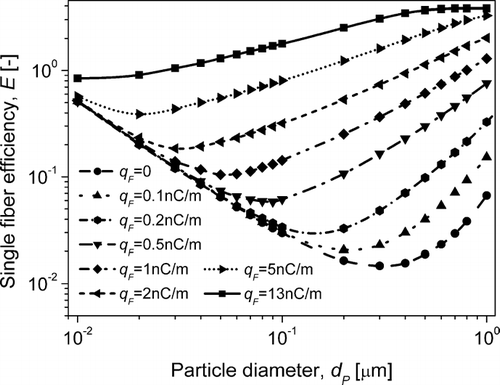
Having determined the single fiber efficiencies for an electret filter, E el , and for a structurally identical, uncharged (mechanical) filter, E mech , both calculated directly using the standard Brownian dynamics approach, the difference Δ E el = E el − E mech was computed then, which can be interpreted as an increase in the single fiber deposition efficiency attributed to the action of polarization forces. The values of this efficiency difference can be correlated with respect to the polarization force parameter, N σ 0. To interpolate the discrete numerical data of Δ E el we proposed the following simple fit:
FIG. 2 Effect of the polarization force parameter (variable particle diameter) on the single fiber deposition efficiency due to electrostatic forces for q F = 1 nC/m (left) and q F = 5 nC/m (right).
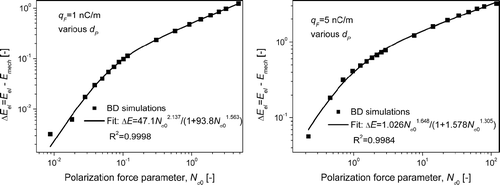
FIG. 3 Effect of the polarization force parameter (variable fiber charge density) on the single fiber deposition efficiency due to electrostatic forces for d P = 0.1 μ m (left) and d P = 1 μ m (right).
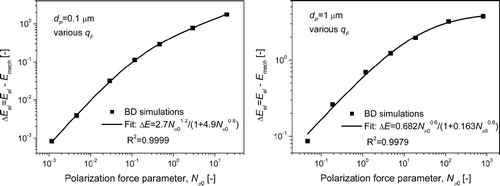
FIG. 4 Collection of all numerical data (points) obtained using the BD method and comparison with individual fits to Equation (Equation22) for fixed q F values (thin dotted lines) and with global fits (two thick, solid and dashed lines, for various ranges of N σ 0 variability).
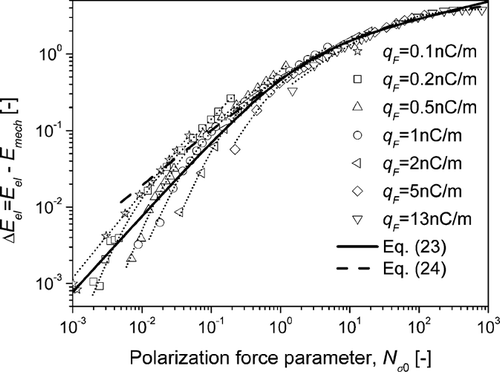
The thick solid line in is plotted according to Equation (Equation23). On the other hand, excluding from the fitting procedure the data deviating the most from the common relationship Δ E el (N σ 0), i.e., for N σ 0 < 5 × 10− 3 and for d P ≤ 0.3 μ m, another correlation was derived, which is shown in as the thick dashed line:
FIG. 5 (a) Effect of gas velocity (left) and (b) effect of fiber diameter (right) on the Δ E el (N σ 0) relationship.
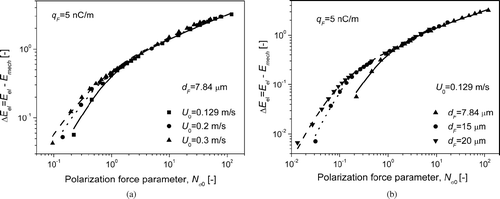
It should be borne in mind that the Equations (Equation23) and (Equation24) were derived using the data obtained for the constant filter packing density α = 0.069. Although the definition of the polarization force parameter N σ 0 does not contain α, it is clear that the single fiber deposition efficiency remarkably depends on the filter packing density in both mechanical and electret filters. Thus, to make our correlations more widely applicable, we have proposed approximate generalization of the Equations (23) and (24). The method to recalculate these formulae for other values of α is described in detail in the Appendix. This generalization involves introduction of the Kuwabara number, Ku (called also the hydrodynamic factor), which is related to α as follows:
Equation (Equation23) is extended to: | |||||
Equation (Equation24) transforms to: | |||||
Equation (Equation26), derived on the basis of a more scattered data set, was proposed for a slightly higher range of applicability and may be even more accurate when nanoparticles are filtered in weakly charged electret media. For intermediate strength of electrostatic interactions and in the case of particles larger than around 0.3 μ m, Equation (Equation27) may turn out to be better. For stronger electrostatic effects, both of them are expected to be of a comparable accuracy.
3.2. Comparison with Experimental Data and Other Correlations
CitationBałazy et al. (2006) measured penetration of neutral aerosol particles through a commercial N95 filtering-facepiece respirator that consisted of three polypropylene fibrous layers. Two of them—the inner and the outer—were electrically neutral, while the middle layer was electrically active. Structural characteristics of this respirator reported by the authors are given in .
TABLE 1 Characteristics of the respirator investigated experimentally by CitationBałazy et al. (2006)
Using the BD method described in this article, we determined penetrations of aerosol particles through each layer of the N95 respirator at superficial gas velocity U 0 = 0.129 m/s, i.e., for the same conditions as during the experiments, taking q F = 0 for the inner and the outer layers, and for several assumed values of q F for the middle layer. Then, the overall penetration through the respirator was calculated as the product of penetrations through each layer. As can be observed in , a fairly good agreement between results of direct BD simulations and experimental data was achieved when the charge density of the fibers forming the middle layer was taken to be of the order 1.2–1.3 nC/m. Therefore, it seems that the BD approach may be also a method of indirect theoretical estimation of fibers' charge density in electret filters, the property which is difficult to measure in the case of bipolarly charged fibers.
FIG. 6 Validation of the results of direct BD simulations using experimental data of CitationBałazy et al. (2006) obtained for a commercial respirator.
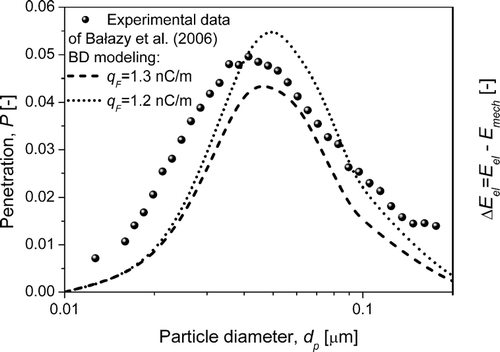
We have also made an attempt to verify applicability of the proposed correlations—Equations (Equation26) and (Equation27)—using the experimental data taken from literature, and to compare our new formulae for Δ E el (N σ 0) with the ones proposed by other authors. Brown (Citation1981, Citation1993) derived the following expression for a fixed filter packing density α = 0.05, assuming that the particle trajectory differs from the fluid streamline only due to the action of the electric field of the fiber (i.e., neglecting particle inertia and Brownian motion):
He suggested that for other packing densities this equation may be generalized as follows:
The same formula was also quoted by CitationKim et al. (2005), CitationLee et al. (2002), and CitationOtani et al. (1993). However, Equation (Equation29) is inconsistent with the original Brown's Equation (Equation28) obtained for α = 0.05. As it was explained in the Appendix, the numerical constant is incorrect—instead of 0.54 it should be 0.41. For values of N σ 0 smaller than one, CitationOtani et al. (1993) proposed the following expressions [see also CitationKim et al. (2005); CitationLee et al. (2002)]:
Experimental data of the single fiber deposition efficiency due to the polarization force as a function of the polarization parameter, Δ E el (N σ 0), were reported for various electrically charged filters by CitationLee et al. (2002) and by CitationKim et al. (2005). CitationLee et al. (2002) studied a polypropylene, melt-blown, high-performance electret filter having the characteristics: d F = 2.64 μ m, α = 0.15, L = 0.31 mm, while CitationKim et al. (2005) investigated a wool filter impregnated with PTFB resin (p-t-butyl-phenol-formaldehyde) with the following parameters: d F = 13.1 μ m, α = 0.075, L = 5.85 mm. Results of Brown's, Otani's and two our correlations, Equations (Equation29), (Equation31), (Equation26), and (Equation27), respectively, were compared with the experimental data of CitationKim et al. (2005)—see , and with these ones of CitationLee et al. (2002)—. Comparing predictions of our new correlations it may be stated that Equation (Equation26) seems to agree better with Kim's data, while for the Lee's data a better agreement is observed for Equation (Equation27). Nevertheless, in both cases our two newly derived formulae for the single fiber efficiency due to the polarization force describe better available experimental data than other correlations that can be found in the literature, Equations (Equation29), (Equation30), (Equation31). Especially, our new theoretical equations cover in a continuous way a very broad range of values of the polarization force parameter. Contrary to that, each of the Equations (Equation29), (Equation30), (Equation31) was recommended for a narrower scope of N σ 0, and they are, in general, mutually discontinuous at the boundaries (for N σ 0 = 10–2 and N σ 0 = 1).
FIG. 7 Comparison of various correlations Δ E el (N σ 0) with experimental data of CitationKim et al. (2005) for an electrically active resin wool filter.
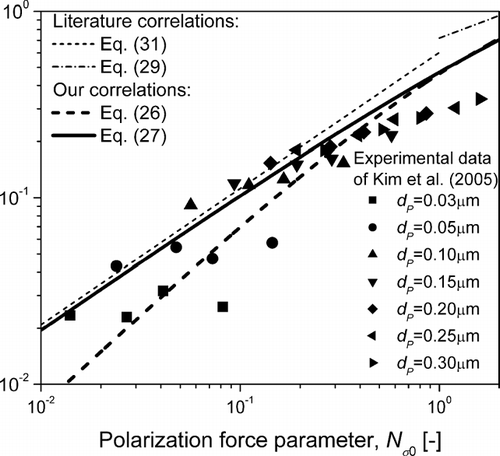
FIG. 8 Comparison of various correlations Δ E el (N σ 0) with experimental data of CitationLee et al. (2002) for a melt-blown polypropylene electret filter.
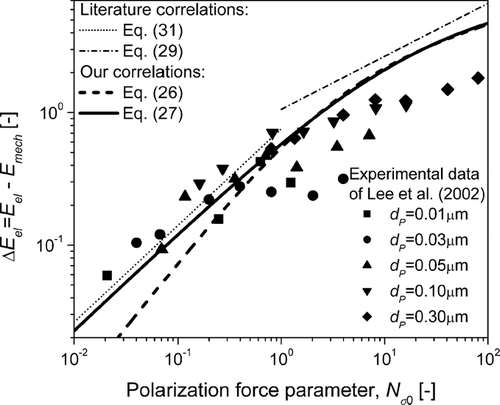
4. SUMMARY AND CONCLUSIONS
The main aim of this article was to derive simple, but more general and accurate formulae than available in the literature, to describe an increase in the single fiber deposition efficiency, Δ E el , due to action of the polarization force, in the case of filtration of neutral submicron aerosol particles through bipolarly charged fibrous filters. For this purpose the Brownian dynamics method was used, which takes simultaneously into account particle convection by moving fluid, random Brownian motion, particle inertia and action of electrostatic forces. Calculations showed that the increase in the fiber charge density results in a significant increase in the deposition efficiency together with the reduction of the most penetrating particle size. Results of extensive numerical simulations allowed us to determine dependence of Δ E el on the dimensionless polarization parameter, N σ 0, for various fiber charge densities and diameters, particle sizes and gas velocities. A simple interpolating formula Δ E el (N σ 0) was proposed and it was proven that it works perfectly when variation of N σ 0 is related to variation of either fiber charge density or particle diameter. Closer inspection of all numerical results led us to derivation of general correlations Δ E el (N σ 0), approximately valid for a very broad range of N σ 0 values. It was also noted that for the finest aerosol particles and weakly charged fibers there is a coupling between Brownian motion and drift of a particle in an electric field, thus the direct BD simulations are preferred then if one requires more precise results. A good agreement between the results of BD calculations and our own experimental data was obtained. Our newly derived correlations Δ E el (N σ 0) were successfully validated using experimental data taken from the literature, showing better agreement than other formulae available so far.
APPENDIX: METHOD OF CORRELATION RECALCULATION FOR ANOTHER PACKING DENSITY
Let us assume that we have determined a correlation for Δ E el for a fixed value of the Kuwabara number, namely Ku1 = const [that corresponds to a filter packing density α 1, Ku1 = Ku(α 1)], which can be generally expressed as an explicit function of N σ 0 as follows:
Example 1: Correlation in a Form of Power Function
Let us assume that Equation (EquationA1) is a power function of N σ 0, i.e.:
Let us analyze in detail the case described by CitationBrown (1981) who claimed that the constants a 1, b 1 in Equation (EquationA4) are equal to: a 1 = 0.47, b 1 = 0.4, for α 1 = 0.05 (i.e., for Ku1 = 0.797), if 1 < N σ 0 < 100. Thus, Equation (EquationA4) reads as: Δ E el (N σ 0)Ku1 = 0.797 = 0.47N σ 0 0.4. Hence, according to Equation (EquationA7), we have: a = 0.47 × 0.7971 − 0.4 = 0.41, and Equation (EquationA5) takes then the form:
Example 2: Correlation in a Form of Quotient of Power Functions
As it has been shown in this article, Equation (EquationA1) can be conveniently formulated for a wide-range of N σ 0 values in the following form:
Thus, the condition expressed by Equation (EquationA3) implies that:
Therefore, Equation (EquationA12) may be finally rewritten for any value of Ku as follows:
Equation (EquationA18) was used in this article to recalculate correlations (23)–(24) derived for α = 0.069 for other values of the filter packing density, resulting in Equations (Equation26)–(Equation27).
Note that the above described procedure of recalculation of the correlation established for a fixed value of α for another value of the filter packing density is approximate (in phenomenological sense, not numerically) and direct BD simulations for a considered value of α should be rather preferred if very precise results are required. Notwithstanding, for typical ranges of values of fibrous filters' packing densities, this simple approach can be fairly satisfactory and it may serve as a quick and reasonable estimate.
Acknowledgments
The work was financed from the budget means for science in 2006–2009 as a research project.
REFERENCES
- Allen , M. D. and Raabe , O. G. 1985 . Slip correction measurements of spherical solid aerosol particles in an improved Millikan Apparatus . Aerosol Sci. Technol. , 4 ( 3 ) : 269 – 286 .
- Bałazy , A. , Toivola , M. , Reponen , T. , Podgórski , A. , Zimmer , A. and Grinshpun , S. A. 2006 . Manikin-Based Performance Evaluation of N95 Filtering-Facepiece Respirators Challenged with Nanoparticles . Annals of Occupational Hygiene , 50 ( 3 ) : 259 – 269 .
- Bałazy , A. and Podgórski , A. 2007 . Deposition Efficiency of Fractal-Like Aggregates in Fibrous Filters Calculated Using Brownian Dynamics Method . J. Colloid and Interface Science , 311 : 323 – 337 .
- Barrett , L. W. and Rousseau , A. D. 1998 . Aerosol Loading Performance of Electret Filter Media . Amer. Indust. Hygiene Assoc. J. , 59 ( 8 ) : 532 – 539 .
- Baumgartner , H. P. and Löffler , F. 1986 . The Collection Performance of Electret Filters in the Particle Size Range 10 nm-10 μ m . J. Aerosol Sci. , 17 ( 3 ) : 438 – 445 .
- Baumgartner , H. P. and Löffler , F. 1987 . Particle Collection in the Electret Fibres Filters a Basic Theoretical and Experimental Study . Filtration & Separation , : 346 – 351 . September/October
- Brown , R. C. 1981 . Capture of Dust Particles in Filters by Line-Dipole Charged Fibres . J. Aerosol Sci. , 12 ( 4 ) : 349 – 356 .
- Brown , R. C. 1993 . Aerosol Filtration: An Integrated Approach to the Theory and Applications of Fibrous Filters , Oxford : Pergamon Press .
- Brown , R. C. and Smith , P. A. 1999 . “ Triboelectric Charging of Filters, and Charge Configuration ” . In Electret Filters, Production and Properties , Edited by: Stenhouse , J. I. T. , Gradoń , L. and Marijnissen , J. C. M. 19 – 28 . Delft : Delft University Press .
- Cao , Y. H. , Cheung , C. S. and Yan , Z. D. 2004 . Numerical Study of an Electret Filter Composed of an Array of Staggered Parallel Rectangular Split-Type Fibers . Aerosol Sci. Technol. , 38 ( 6 ) : 603 – 618 .
- Cheung , C. S. , Cao , Y. H. and Yan , Z. D. 2005 . Numerical Model for Particle Deposition and Loading in Electret Filter with Rectangular Split-Type Fibers . Computational Mechanics , 35 ( 6 ) : 449 – 458 .
- Elimelech , M. , Gregory , J. , Jia , X. and Williams , R. A. 1995 . Particle Deposition and Aggregation , Boston : Butterworth-Heinemann .
- Ermak , D. L. and Buckholz , H. 1980 . Numerical Integration of the Langevin Equation: Monte Carlo Simulation . Journal of Computational Physics , 35 : 169 – 182 .
- Jaworek , A. , Krupa , A. and Czech , T. 2007 . Modern Electrostatic Devices and Methods for Exhaust Gas Cleaning: A Brief Review . J. Electrostatics , 65 ( 3 ) : 133 – 155 .
- Ji , J. H. , Bae , G. N. , Kang , S. H. and Hwang , J. 2003 . Effect of Particle Loading on the Collection Performance of an Electret Cabin Air Filter for Submicron Aerosols . J. Aerosol Sci. , 34 : 1493 – 1504 .
- Kim , J. C. , Otani , Y. , Namiki , N. and Kimura , K. 2005 . Initial Collection Performance of Resin Wool Filters and Estimation of Charge Density . Aerosol Sci. Technol. , 39 : 501 – 508 .
- Kuwabara , S. 1959 . The Forces Experienced by Randomly Distributed Parallel Circular Cylinders or Spheres in a Viscous Flow at Small Reynolds Numbers . Journal of the Physical Society of Japan , 14 ( 4 ) : 527 – 532 .
- Lee , M. , Otani , Y. , Namiki , N. and Emi , H. 2002 . Prediction of Collection Efficiency of High-performance Electret Filters . J. Chem. Engineering Japan , 35 ( 1 ) : 57 – 62 .
- Martin , S. B. Jr. and Moyer , E. S. 2000 . Electrostatic Respirator Filter Media: Filter Efficiency and Most Penetrating Particle Size Effects . App. Occupat. Environ. Hygiene , 15 ( 8 ) : 609 – 617 .
- Oh , Y. W. , Jeon , K. J. , Jung , A. I. and Jung , Y. W. 2002 . A Simulation Study on the Collection of Submicron Particles in a Unipolar Charged Fiber . Aerosol Sci. Technol. , 36 ( 5 ) : 573 – 582 .
- Otani , Y. , Emi , H. and Mori , J. 1993 . Initial Collection Efficiency of Electret Filter and Its Durability for Solid and Liquid Particles . J. Chem. Engineer. Japan , 11 : 207 – 214 .
- Podgórski , A. 2001 . Brownian Dynamics—II. Algorithms for Stochastic Simulations of a Solid Spherical Aerosol Particle Motion Near a Solid Wall . J. Aerosol Sci. , 32 : S713 – S714 . (Suppl. 1)
- Podgórski , A. 2002 . On the Transport, Deposition and Filtration of Aerosol Particles in Fibrous Filters: Selected Problems , Warsaw : The Publishing House of the Warsaw University of Technology .
- Podgórski , A. , Bałazy , A. and Gradoń , L. 2006 . Application of Nanofibers to Improve the Filtration Efficiency of the Most Penetrating Aerosol Particles in Fibrous Filters . Chemical Engineering Science , 61 : 6804 – 6815 .
- Romay , F. J. , Liu , B. Y. H. and Chae , S. J. 1998 . Experimental Study of Electrostatic Capture Mechanisms in Commercial Electret Filters . Aerosol Sci. Technol. , 28 : 224 – 234 .
- Walsh , D. C. and Stenhouse , J. I. T. 1996 . The Effect of Particle Size, Charge, and Composition on the Loading Characteristics of an Electrically Active Fibrous Filter Material . J. Aerosol Sci. , 28 ( 2 ) : 307 – 321 .
- Wang , C. S. 2001 . Electrostatic Forces in Fibrous Filters—a Review . Powder Technology , 118 : 166 – 170 .